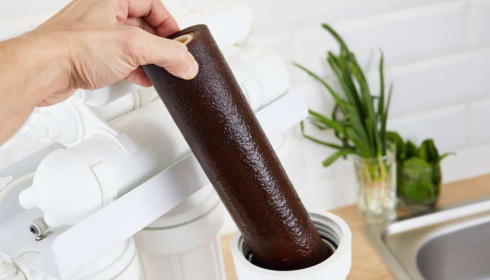There’s something oddly personal about the water in your home. You drink it, cook with it, wash in it — it literally touches every part of your daily life. And when it starts acting up, even in the smallest ways, you feel it.
Maybe you’ve noticed your sink fixtures turning an odd greenish-blue color, or there’s that faint rotten-egg smell coming from the tap. It’s easy to brush off at first, but after a while, those small annoyances start to whisper that something’s off. And the truth is — they’re not just cosmetic issues. They’re signs.
Your water might be trying to tell you something.
When Water Starts Leaving Clues
Let’s start with that strange turquoise or blue-green tint that sometimes appears around your sinks or drains. At first glance, it might look like leftover cleaner or some random discoloration. But if it keeps showing up, you’re likely dealing with blue green staining, a common symptom of low pH water — meaning your water is slightly acidic.
Acidic water slowly eats away at copper pipes, pulling small amounts of metal into your water supply. Over time, those dissolved copper particles deposit on surfaces, leaving behind that signature blue-green trace.
It’s not dangerous right away, but it’s a red flag. That corrosion can eventually cause pinhole leaks, ruin fixtures, and even affect water taste. And if you’ve ever wondered why your water sometimes leaves a metallic aftertaste — there’s your answer.
The Mystery of the Rotten-Egg Smell
If there’s one water problem you’ll never forget once you smell it, it’s the infamous sulfur smell — that unmistakable “rotten egg” odor that can make you question your plumbing (and your life choices).
This odor comes from hydrogen sulfide gas, produced either by bacteria in your plumbing system or naturally occurring sulfur compounds in groundwater. It’s not typically harmful, but it’s definitely unpleasant — especially when it hits your shower steam first thing in the morning.
What’s tricky is that the smell can come and go. Sometimes it’s worse in hot water, sometimes only from certain faucets. The culprit could be as simple as a magnesium anode rod reacting with bacteria in your water heater, or as complex as well contamination.
Whatever the source, it’s fixable — and worth fixing. Because clean, fresh-smelling water shouldn’t be something you have to get used to.
Water Issues: The Hidden Cost of Ignoring Them
We often underestimate how much bad water can quietly wear down a home. Acidic water corrodes pipes. Hard water clogs them. Sulfur compounds stain laundry and make your skin dry. And if you’re relying on untreated well water, there’s a whole list of minerals and bacteria that could be creeping through unnoticed.
These aren’t just maintenance problems. They affect everything — from how long your water heater lasts to the softness of your towels. Even how your morning coffee tastes.
Yet, people get used to it. They buy bottled water for drinking, deal with stains in the shower, and pretend the smell in the bathroom is “just how it is.” But the longer these problems linger, the worse — and more expensive — they get.
The Science Behind Soft, Balanced Water
Water treatment isn’t about fancy equipment; it’s about restoring balance. The right system brings your water back to a state where it’s gentle, clean, and neutral — neither too acidic nor overloaded with minerals.
So how does it work? A softener removes calcium and magnesium, the minerals that cause scaling and hardness. Meanwhile, a neutralizer can raise your water’s pH to stop it from eating away at your pipes. And filtration systems can trap or oxidize sulfur and iron before they reach your faucets.
It’s chemistry doing what chemistry does best — quietly solving problems in the background while you just… live better.
Why Modern Water Systems Are Easier Than Ever
Gone are the days when water softeners were clunky, confusing, and high-maintenance. Today’s systems are designed to fit seamlessly into your home life — efficient, sleek, and smarter than ever.
Take a user friendly salted water softener, for example. It does all the heavy lifting for you — automatically regenerating when needed, using less salt, and letting you monitor everything through a simple interface. You don’t have to be an engineer or a plumber to manage your water anymore.
And if you’ve ever lugged 40-pound salt bags down the basement stairs, you’ll appreciate how modern systems use less salt while maintaining better performance. It’s a quiet upgrade that makes your entire home feel fresher and cleaner.
The Little Things That Make a Big Difference
Once you’ve experienced properly balanced water, you start noticing small luxuries that weren’t there before. Your skin feels softer. Your laundry smells cleaner. You’re not scrubbing mineral rings out of the toilet every week. And that lingering smell from the tap? Gone.
It’s not about being fancy — it’s about comfort. Your home should feel right, and water plays a bigger role in that than most people realize.
It also saves you money in the long run. Appliances last longer, pipes don’t corrode as quickly, and your water heater doesn’t have to fight through mineral buildup. Efficiency feels good, especially when it’s something you don’t have to constantly think about.
The Human Side of Clean Water
There’s something grounding about knowing your water is safe, soft, and pure. It’s one less thing to worry about in a world full of noise and uncertainty.
When you turn on the tap, you shouldn’t be second-guessing. You shouldn’t be wondering if that smell means something’s wrong or why your sink looks stained again. It’s supposed to be simple.
And when it finally is — when your water just works — it’s almost invisible. That’s the beauty of it. It just becomes part of your home’s rhythm again.
How to Know If You Need a Fix
Not every problem screams for attention. Sometimes, it’s subtle — a faint odor, a dull taste, or a slow buildup on faucets. If you’re unsure, start with a basic water test. Many local providers or hardware stores offer kits that can detect acidity, hardness, iron, and sulfur levels.
You don’t need to guess — you just need data. Once you know what’s in your water, you can match it with the right solution. Whether that’s a neutralizer, softener, or filtration unit, the key is addressing the cause, not just the symptom.
Final Thoughts
At the end of the day, water is something you shouldn’t have to think about — but it’s also something worth caring about. It’s the quiet hero of your home, running behind the scenes, shaping how your days feel without you even realizing it.

